The Savannah Monitor is one of the smallest and most popular species among the monitor genus.
They are popular because they are very friendly and are easier to keep than other larger monitors.
This does not mean they are suitable for beginners and they still require advanced care.
Known to like insects and small mammals, they are an inactive pet and will spend most of their time basking or lounging in their enclosure.
These African lizards need to live in large enclosures with high temperatures. If you are interested, read one below to find out how to care for them…
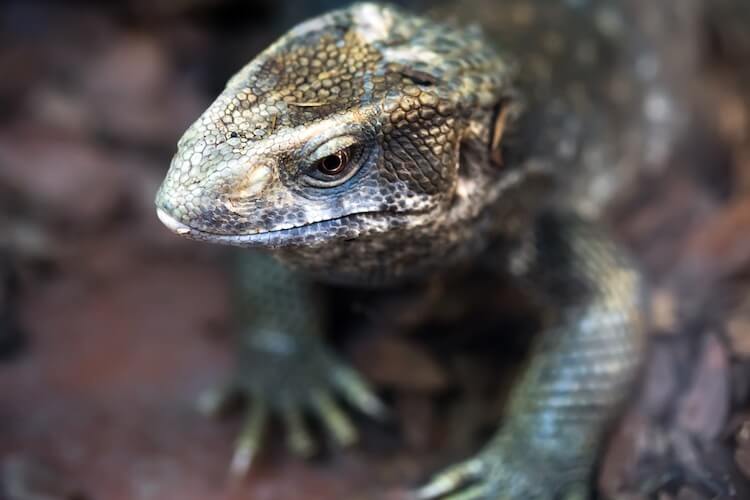
Savannah Monitor Overview
Savannah Monitors are naturally found in sub-Saharan Africa. As their name implies (savannah terrain), they like to live among the rocky desert and woodlands.
This species is used to the hot temperatures of sub-Saharan Africa. They naturally soak themselves in pools of water to keep cool.
Reptile owners love them because they have a very docile nature when compared with larger monitor species.
Grayish-tan in appearance, they have spots on their backs and rings on their short tails.
They eat a variety of invertebrates and small mice. In the wild, they hunt using their tongue to pick up chemical cues from the environment they live in.
Solitary lizards, they will only interact with their own species during the breeding season. If you are planning to keep this reptile, it should be the only one you have in the enclosure.
Unfortunately, they are considered to be endangered by some organizations due to hunters seeking them out for their skin.
What We Like About Savannah Monitors
Pros
- One of the friendlier monitor species, they make a great first monitor.
- Relatively few health issues and are very hardy.
- Can survive in low humidity and have low husbandry requirements.
- They can grow up to three feet in length and weigh as much as 11 pounds. Grayish-tan in color, they have dorsal spots and rings on their tail.
Cons
- This species must be housed alone. You cannot have more than one in an enclosure at once.
- They need a very big enclosure and their housing set-up may be costly.
- Savannah Monitors are carnivorous; eating insects as well as the occasional rodent.
- They require extremely high temperatures in their basking spot.
Species Appearance
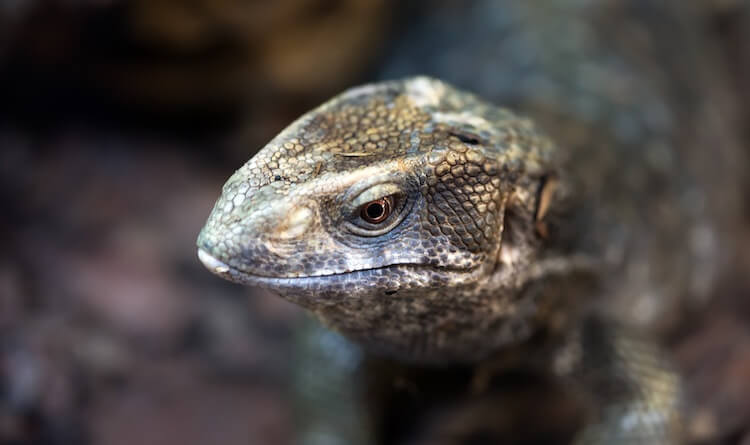
There are five subspecies of the Varanus exanthematicus, so their appearance and size will vary based on which species you purchase.
However, all Monitors have deeply forked tongues. This helps them pick up chemical signals from their environment.
Their typical appearance is stocky and thick with a wide head.
They have a short neck and tail.
You may need to rely on a veterinarian or expert herpetologist to sex your lizard, because there is no true sexual dimorphism. This makes it very difficult to tell males and females apart.
How Big Will a Savannah Monitor Get?
Full grown Savannah Monitor lizards are between two to four feet in length by four years old. They can weigh as much as 13 pounds.
At birth, Babies are only a couple inches long, but they grow incredibly quickly.
Color Variations and Markings
This species has a gray-brown base color with have dark-edged yellow spots on their back. They have a bluish tongue and yellow and brown rings on their tail.
Savannah Monitor Enclosure
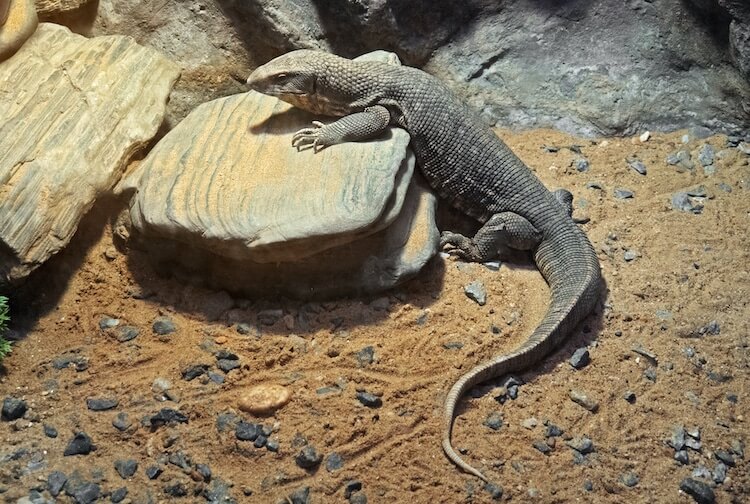
This lizard lives in a natural habitat of rocky deserts and forests in Africa’s wild savannah.
They are relatively inactive in the wild. They will spend much of their time basking and soaking themselves and will likely display similar behaviors in their enclosures.
Because they like to spend plenty of time soaking and in the forest, their cage should have some logs, branches, rocks, and even cork bark slabs.
Any of these items will work as long as they can be easily cleaned or removed for cleaning.
Savannah Monitor Cage & Set Up
Although they are only considered a medium-sized monitor Savannahs are still a large reptile.
They need a large enclosure which should have a space of about 5ft x 4ft x 4ft – if not more.
Their tank will likely need to be custom made and should be ready for when you bring your lizard home.
Enclosures should be made of plexiglass or plastic.
The top of their enclosure should have a screen to allow for airflow, whilst being secured to prevent any escapes. These monitors are very strong and smart.
Baby Savannah Monitors should be kept in 50-gallon tanks. This tank will be big enough for their first six months.
They grow quickly so some reptile owners decide to put them directly into their adult enclosures:
- Tank Type: plastic or plexiglas cage.
- Tank Size: 5ft x 4ft x 4ft minimum.
- Lighting: UVB and high wattage basking bulb required.
- Substrate: newspaper.
Active during the day, they require a UVB light for essential vitamin production, especially for babies! Lighting should be on for about 12 hours of light and 12 hours of darkness each day. You should also use an incandescent bulb to create a very hot basking spot. Make sure the incandescent light is out of reach from your monitor.
In terms of temperature, the daytime gradient in the enclosure should be 80℉-95℉.
A basking spot should be even warmer, as high as 120℉ is ideal.
Being a desert-type lizard, Savannah Monitors are not as picky about their humidity levels as many other reptiles.
In their natural environment, it is very dry and arid. Because of this, the basking spot can be kept at very low humidity. The rest of the tank should be kept at between a 50 to 60% humidity.
The water-pool in your Savannah Monitor’s enclosure should be large enough to soak in too.
Finally, because monitors are messy, a suitable substrate would be something that can be cleaned easily! It will need to be spot cleaned every day and thoroughly cleaned out at least once a week.
Given that they will be in a large enclosure a substrate like newspaper will be the easiest to clean. Make sure not to use sand or gravel as this can cause bowel obstruction, especially in Juveniles.
You should also avoid reptile carpet as it can entangle and tear their large claws.
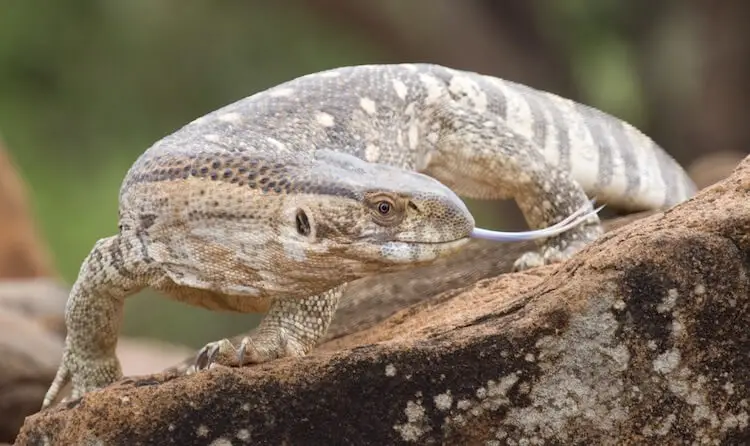
Cleaning & Misting
As a species, monitors are very messy and defecate frequently. They have a tendency to defecate in their water, so be sure to monitor it carefully and immediately change it if it becomes dirty.
Their pool of water should contribute to keeping the tank at mid-level humidity, and you should not have to mist the tank. The best way to keep track of this is to place a humidity gauge on the cool side of the tank and only mist if the humidity falls below 40%.
Their enclosures must be cleaned frequently.
Feces should have a normal solid brown part and a solid white part too. If it is unusually colored or textured, this may be a sign of a health problem.
Feces should be spot cleaned every day from their enclosure, especially if it is in their water.
The entire tank should be thoroughly cleaned out every week or two.
This may require removing substrate or various logs and branches and temporarily homing your monitor somewhere else.
Savannah Monitor Care
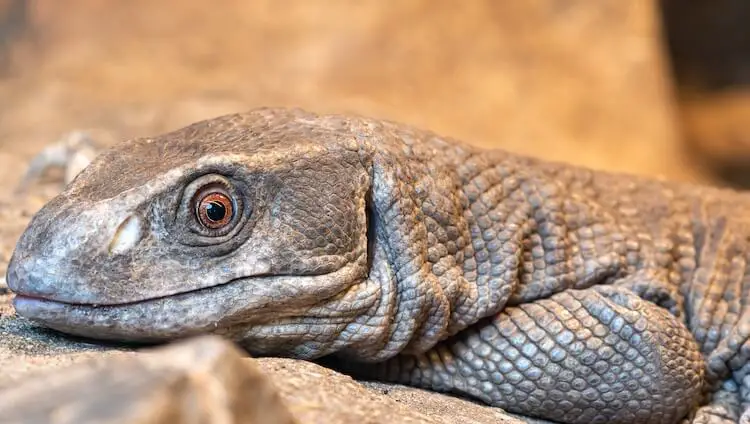
Savannah Monitor Diet
This Lizard eats a variety of invertebrates and small mammals in the wild. They are not picky about what they eat and may eat insects, mealworms, small mice, or even snails. You can on occasion feed a mouse. They may also eat thoroughly cooked pieces of beef, but ideally they should stick to mice and invertebrates.
A carnivorous reptile, they hunt and sense their environment by flicking their tongue to pick up chemical cues.
Food should be dusted with a calcium supplement, and a multivitamin should be fed if you are not feeding mice to your monitor.
When you feed your monitor, place the food into the cage so that they can forage for it. This keeps them more active:
- Adults should be fed several insects 1-2 times a week (larger monitors may eat less frequently).
- Juveniles should be fed 2-3 times per week.
- Babies should be fed every other day.
Baby Savannah Monitors will eat the same basic diet, anything from crickets and waxworm larva to pre-weaning mice.
Any live food, for adults or babies, should be removed at the end of the day if uneaten.
Finally, monitors should always have access to clean water.
Their water bowl should be large enough for them to soak in; built-in containers or plastic pans work great.
Savannah Monitor Lifespan & Health
Savannah Monitors live about 12 years in captivity but can live up to 20 years with good husbandry.
They usually have few health issues in captivity, especially if they are captive-bred.
Two distinct problems may occur with a poor diet:
- Metabolic bone disease can result from a lack of calcium and may cause your lizard to feel sluggish.
- Obesity can result from overfeeding your monitor. If your Lizard starts abnormally gaining weight, you may need to restrict the amount of food they are consuming temporarily.
Wild-caught Monitors are prone to having parasites, which is one reason that you should acquire this species through a breeder.
They enjoy soaking themselves, so you shouldn’t need to bathe them.
Signs They Are Healthy
- Basking and soaking normally.
- Eager to eat.
- Clear and bright eyes.
Sickness Symptoms
- Lethargic and sluggish.
- Sudden weight gain.
- Dragging their limbs or tail.
Typical Behavior
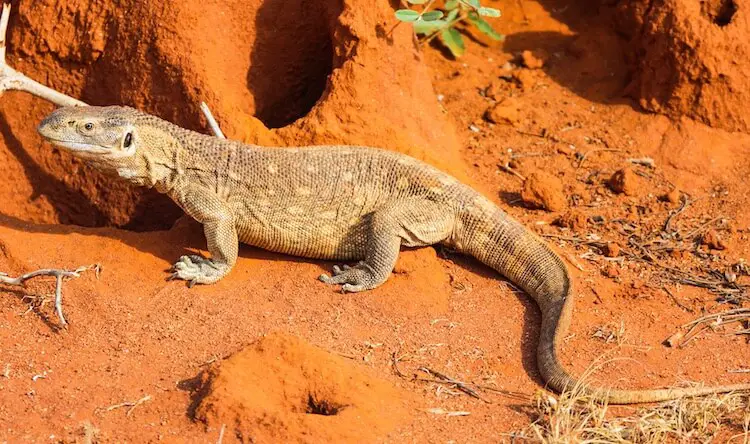
When not in captivity, the Savannah Monitor is a solitary reptile and will only socialize with its own species during its breeding season.
Known for being very territorial, males will fight if they come into contact with one another.
They are not particularly active creatures and will spend time lounging in or out of the basking spot.
Most of their time will be spent basking and occasionally foraging for food, they do this with tongue flicking. Tongue flicking in captivity may indicate that your monitor is hungry or just being curious.
They only communicate with each other through pheromones and other chemical signals which they detect with their tongue.
Mating and fighting will show different forms of communication.
To ward off predators, they might hiss loudly and thrash their tail, or it may play dead as a last resort.
These creatures must be housed alone due to their territorial behavior towards other lizards.
Are Savannah Monitors Friendly?
Yes, especially as far as monitors go. They are a very friendly species and can be taught to tolerate handling over a period of time.
They are generally one of the less nervous monitor species so get along well with their owners.
However, they are strong lizards and require a strong grip.
Once tame they may not show aggression to you.
A wild adult can deliver a strong bite or nasty scratch it not socialized properly.
Handling Advice and Tips
The Savannah Monitor is one of the most docile species among the monitor genus. However, this does not mean they tame easily.
Monitors require a lot of patience and work from their keeper to to be well-socialized.
Safe handling requires lots of face time and repetitive handling.
It is a commonly known fact that most reptiles carry Salmonella bacteria. Washing your hands before and after handling is good for your health and can prevent infections.
Another problem owners may find during handling are scratches from their lizard’s nails.
The best way to handle your monitor is to place a firm grip behind the reptile’s head and put one hand near the hind limbs.
Baby Savannah Monitor
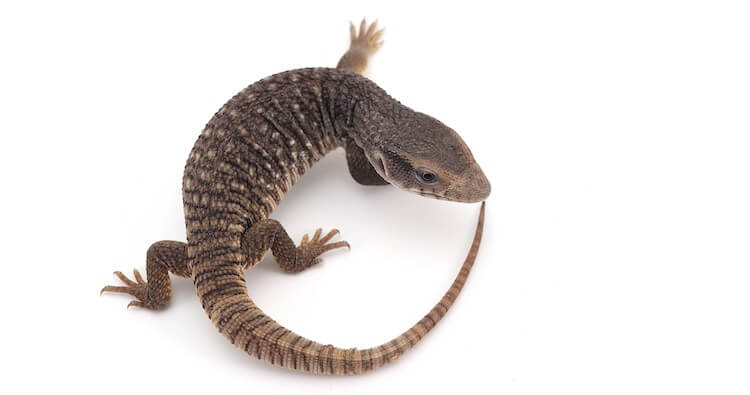
The breeding season occurs during the wet season (i.e. May). A male will follow a female and will periodically bite and scratch her neck until she allows copulation.
Females need a nest box to lay eggs. In the wild, she would usually make her own or lay them in a termite mound. For your monitor, a suitable nest box can be a plastic tub filled with soil.
After she lays her eggs, they should be incubated in groups in a ten-gallon aquarium filled with vermiculite and water.
There is a 5-6 month incubation time, and the container should be opened occasionally to let oxygen in. They should be incubated at 82℉, and the temperature and moisture should be monitored carefully.
There are usually 20-50 eggs per clutch.
Hatchlings are a couple inches long at birth.
They will start eating insects and other invertebrates a week after hatching. They will need to be feed nearly every day at the start and then less often as they age (see diet guide above).
Buyer’s Guide
Savannah Monitors are one of the more readily available monitors and cost about $50 to $100 USD.
It is strongly recommended that you obtain your Lizard from a trusted breeder, rather than somewhere where they are wild-caught.
Wild-caught monitors are highly prone to having parasites and are often stressed when forced to adapt to a captive lifestyle. Breeding them in captivity can be difficult, so while finding a captive-bred monitor may prove to be more of a challenge, it is worth the effort for your experience and the species’ protection.
Savannah Monitor Facts
| Vital Facts | |
|---|---|
| Common Name | Savannah Monitor |
| Scientific Name | Varanus exanthematicus |
| Price | ~$100 |
| Size | 2.5 to 4 feet long |
| Lifespan | 12 to 20 years |
| Diet | Insects and other invertebrates |
| Tank Size | Minimum 5ft x 4ft x 4 ft |
| Humidity & Temperature | Daytime temperature: 80℉-95℉ Basking Spot: 100°F-120°F Humidity: 60% |
| Popular Alternatives | Ackies Monitor, Black or White Throated Monitors |
Summary
Savannah Monitors are one of the more docile monitors in the world of reptile keeping.
They do require a high temperature in a large habitat, but they also have an easy feeding routine and are tame.
If you are looking for a smaller breed of Monitor, the Ackies is a very popular choice and is easier for some beginners to handle. If you are looking for more of a challenge, the Black or White-Throated Monitor is a good idea.
They can make a great and fascinating addition to a home, will it be for you?


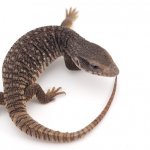

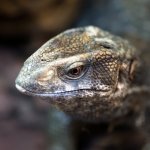

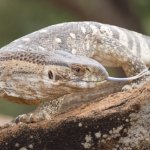
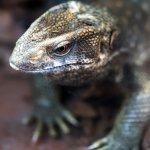
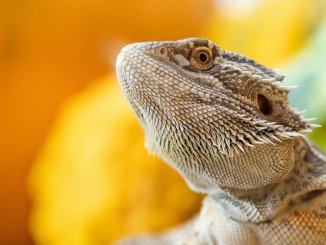
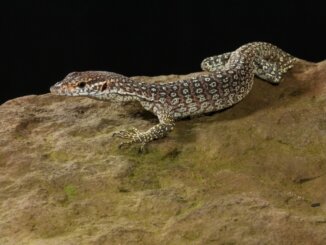
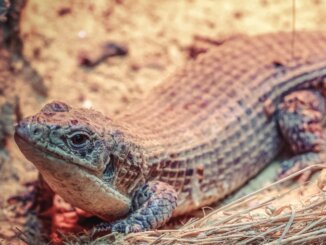

I inherited my monitor and he was poorly caref for. Hes deformed in the back hip. He seems ok and gets around fine. My problem is he’s aggressive. He tries to bite me and hisses when I approach him or try to put his food in his environment. Any suggestions?
Hi Tracy, yes they can be food and territory aggressive. Was he wild-caught? If so, this behavior is natural for him. Using leather welding gloves is a good idea for feeding if he is biting. Out of interest how big is his enclosure and does he tail whip? Some won’t ever tolerate handling or calm down.
I need help setting up my reptile tank for my baby savannah monitor. I have got him in a 10-gallon right now, but I’m getting a 55-gallon tank from a friend.
Hi Ezekiel, a 55-gallon tank is suitable for a baby, but you will soon need a much larger enclosure. You can read more about reptile terrariums here.
Some a**hole left a savannah in a pillowcase on my doorstep (not the first time I’ve had a reptile dumped on me like that sadly, I do have a reputation as the crazy reptile lady. I suppose charitably it’s a step up from dumping them in the local park but still…) Anyway, vet estimation is that he’s somewhere around 1-1½ years give or take and he might even be a bit older. He’s too healthy to be a wild caught specimen (no scars from fights, no parasites, no injuries) so best bet someone got him and realized how big he/she would get after the fact (google exists people, do your f-ing research before purchasing a pet) then chose to dump him with the crazy lady who walks their basilisk down the street. He’s currently in the 8x8ft grow tent because it’s cold over here and space is cheaper in a grow tent then the ridiculous costs for a custom. He/she already has some nose rub and what looks like some stuck shed on his/her back. Real problem is his aggression. Hissing, tail whipping, snapping in my direction even when I’m just cleaning out the waterdish and nowhere even near him. All my reptiles were breeder bought as babies and either friendly from the beginning or at least willing to give me the benefit of the doubt. This guy won’t even eat in my presence and if it weren’t for the flipped container I wouldn’t even be able to tell if he was eating. I’m not looking for an insta-fix, especially given monitor behavior in general, but how do I go from his rather strong desire to see me in pieces to at least being able to tong feed. How am I supposed to get him/her to tolerate me if I can’t even establish a food based bond? He’s only going to get bigger and I would prefer to keep my fingers should I need to take him to a vet at any point. And damn can those little guys hiss, I can hear him clear upstairs when he’s really going at it. How can a foot and a bit plus tail make so loud a noise?
Wow! What a story! Grumpy teenagers: are a cross-species problem. Especially one that was mistreated and ultimately abandoned on your doorstep… you expect nothing different. Trauma is a real issue and his brain is certainly wired to fear and hate humans right now. Insta-fix, unfortunately, is not an option. You want a slow build up of trust, that you can achieve following these steps and considering these pieces of information:
Try to spend hours around him, have a sit and read a book or stay on your phone: he needs to get used to you, your smell, movements, as a non-threatening source of disturbance. It is useful, during this time, to not make eye contact, to always wear the same color clothes, to always make slow and gentle movements and to give him/her a vantage point: don’t be up above, but rather on the side or even below him/her. The aim is to see him exit the defence mode he’s in whenever he sees you right now. When he stops hissing and wigging its tail, when he enters a more thinking mode, only then you can start offering food, from a distance, with slow movements. When you manage to feed successfully you can start placing your hand near him, and even touching it. If you read your reptile well, you’ll know when he’s about to snap (you described the signs) as opposed to when he’s in a calmer, safer mindset (long and lateral tongue flicking, blinking, not minding you etc…). The latter case is when you can slowly start getting closer, with as little eye contact as possible and, for your safety, no protruding fingers to be bitten. Try not to be scared, for fear tenses up your movements and he/she will without a doubt perceive that as a ‘situation’.
As you know, you are dealing with an extremely intelligent animal, approach it as such: some actions that seem meaningless (like minding your own business where and when he can see you) can go a long way. Before you know it, you will be walking him down the road too! Additional piece of advice: make sure he can’t see much movement in his enclosure, whether you are there or not (e.g. no birds out the window or moving cars on the road). Hope this helps!